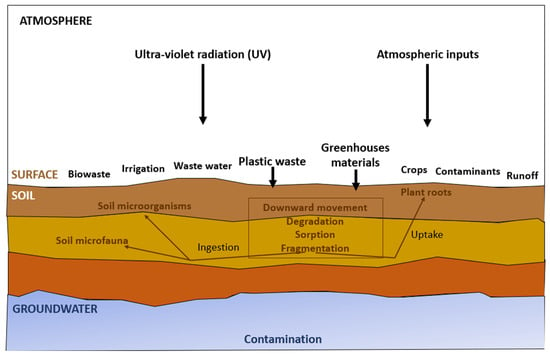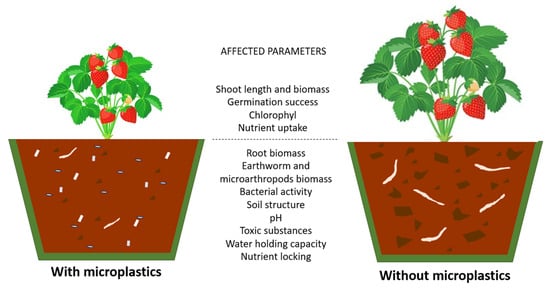You're using an outdated browser. Please upgrade to a modern browser for the best experience.
Please note this is a comparison between Version 1 by Jorge Mongil-Manso and Version 2 by Catherine Yang.
Plastics, especially microplastics, are a diverse group of polymer-based particles, currently emerging as a global environmental threat—plastic pollution.
- microplastics
- plastic greenhouse
- plastic mulch
- plastic nets
1. Introduction
Globally speaking, there is a growing interest in the problem of the emergent topic of plastics in general (and microplastics and nanoplastics in particular) from scientific, public, and policy-making points of view [1][2][3][4][1,2,3,4]. Plastics are materials that consist of one or more polymer types. Polymers are chains of molecules that usually contain carbon; they can be crude-oil- or bio-based. While crude-oil-based plastics are typically made from petroleum, bio-based plastics are made entirely or partially from renewable plant-based products such as vegetable oils, corn starch, and sawdust. In general, fibers and fragments are secondary microplastics because they result from the disintegration or degradation of larger plastics. The consequence is that every day, there is more evidence that microplastics could cause environmental changes in terrestrial systems [5][6][7][8][5,6,7,8]. FAO [9] estimated that 12.5 million tons of plastic products are used for agricultural purposes annually, with films accounting for about 40 to 50 percent of this number. Usually, soil is the predominant receptor for agricultural plastic products at the end of their useful lives.
The presence of plastics, especially micro- and nano-plastics (MNPs), in the soil–food chain is already a serious multifactorial food safety problem that has drawn unusual attention from numerous scientists and organizations [10][11][10,11]. During the fifth United Nations (UN) Environment Assembly, which was held in March 2022, a historic decision was made: ending plastic pollution [12]. The decision was made by all 193 UN member states. The question now is how to achieve this goal, especially in the agricultural sector where, depending on their benefits, the use of plastic is increasing daily; this is especially relevant regarding the implications for the cycle of plastics in agriculture (Figure 1).

Figure 1. Cycle of plastics in agriculture (adapted from: [13]). According to these authors, plastic particles that enter the soil surface are incorporated into deep soil layers through tillage, animal activities, or water infiltration. Subsequently, plastics can be degraded by UV radiation, thermal oxidation, microbial action, or interaction with soil colloids (organic matter or clay minerals).
Abundance of Plastics in Soils
Several studies have shown that the global production of plastics has increased substantially, causing the so-called ‘plastic pollution’ to reach an unprecedented level [14][15][16][14,15,16]. Globally, the area of the world occupied by greenhouses at the beginning of the 21st century exceeded 450,000 ha [17].
The typology of greenhouses is varied. Based on the shapes and materials used, these houses can either be flat or vine-type, in a tunnel or semi-cylinder, in a one- or two-water chapel, with raspa or feint, asymmetrical or symmetrical, etc. [18][19][20][18,19,20].
Carus et al. [2] estimated that the global production of bio-based polymers amounted to 3.5 Mt in 2018, 3.8 Mt in 2019, and 4.2 Mt in 2020. In 2021, Plastics Europe [21] stated that 367 Mt were produced worldwide. Microplastics in Fisheries and Aquaculture [22] stated that of all plastics, microplastics (MPs) have proliferated the most; these are plastic fragment particles whose sizes range from 5 mm to 1 µm, or from 5 mm to 0.1 µm, according to He et al., and Bläsing and Amelung [23][24][23,24]. A good amount of literature [25][26][27][25,26,27] addressed plastic classification based on their size: macroplastics (>5 mm), microplastics (MP, 5000–1 µm), or nanoplastics (<1 µm) [25][26][27][25,26,27].
The greenhouses are subjected to intensive agriculture under plastic. This is especially relevant in Europe, where more than 43% of the greenhouse area in the world is located. According to a European Union (EU) report [28], 175,000 ha of the 405,000 ha greenhouses identified worldwide are located in Europe. Spain, France, Greece, Italy, and the Netherlands are the areas of greatest significance; Spain has the largest area of protected cultivation at 71,783 ha.
According to Abbate et al. [29], Spain, the United States, China, and Italy are the countries that have contributed the most to knowledge on biodegradable mulch. However, within the Spanish territory, there are certain areas that have hardly been investigated, as they are dedicated to agricultural cultivation without plastic—in fact, greenhouses are not considered a priority. One such region, where the use of plastics in agriculture is gradually increasing, is Castilla y León (CYL) [30][31][32][30,31,32].
Plastics are used in many agricultural activities such as the roofing of greenhouses and modern food storage and preservation systems. Around the middle of the last century, when they first started being used, plastics were thought to have several advantages and, as such, were very welcome. However, this initial idea has changed drastically in recent times, as different types of plastics persist in the environment as non-biodegradable micro- and nano-particles, as pointed out by [33][34][33,34] and even the European Commission’s Group of Chief Scientific Advisors Environmental and Health Risks of Microplastic Pollution [35].
Since the 1960s, global production of plastics has increased 20-fold, exceeding 300 Mt in 2015; it is predicted by the EIP-AGRI Focus Group [36] and Plastics Europe [21] to double in the next 20 years. Therefore, it has become imperative to study and understand how this increase in plastics will impact the ecosystem. Many studies have been conducted on the impact of plastic pollution on aquatic ecosystems [37], but little has been investigated so far on terrestrial habitats [5][38][5,38].
Today, it is imperative to understand the occurrence and distribution of MPs in soils. Therefore, it is essential to address this issue of plastics in agriculture with the greatest possible urgency. In this context, this respapearchr aims to evaluate existing research on plastic in general and MPs in particular, in the agro-environmental soils of CYL, in order to determine the impact of MPs on soil properties, subsidiary agricultural quality, and crop production. Thus, the main objective of this study is to evaluate the current state of studies on MPs in the agricultural soils of CYL.

